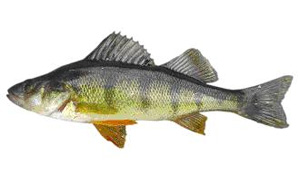Yellow Perch
Perca flavescens
Report it
If you think you have found an aquatic invasive species:
- do not return the species to the water
- take photos
- note:
- the exact location (GPS coordinates)
- the observation date
- identifying features
- contact us to report it
Identifying features
- An elongate, oval body;
- A moderately long, blunt snout that does not extend beyond the lower jaw;
- Two well-separated dorsal fins;
- The back and top of the head ranges in colour from bright green to olive to golden brown and this colour extends downwards to form six to eight vertical bars over the yellow to yellow-green sides;
- The underside is white;
- The dorsal and caudal fins are yellow to green, the anal and pelvic fins are opaque yellow to silver white, and the pectoral fins are amber and transparent.
Where it has been found
The Yellow Perch is a freshwater fish with an almost circumpolar distribution in the northern hemisphere. In Canada it can be found from Nova Scotia and Quebec, west to Great Slave Lake in the Northwest Territories. This small, prolific fish is especially abundant in Manitoba lakes and in the Great Lakes drainage system. In B.C., the Yellow Perch has been introduced to the Pend Oreille, Kootenay and Okanagan watersheds.
Habitat
The Yellow Perch is a cool-water species and is most abundant in the open water of lakes with moderate vegetation, clear water and bottoms of muck, sand or gravel.
Ecological and economic impacts
The Yellow Perch directly competes with trout and salmonid species for planktonic food and preys on the juveniles of other fish species. It out-competes salmonids, though the impact may be lessened in large lakes. The presence of predatory fish that consume Yellow Perch may lessen their impact on the native species.
Origins and mode of arrival
Native from North America
Mode of dissemination
Once established, populations of non-native fish can disperse through connected waters into adjacent habitats.
There are many pathways for their introduction that are linked to human activities, including: recreational and commercial boating, construction of new canals and water diversions, releases from live food fish markets, releases from the aquarium and water garden trade, use of live bait, illegal introductions to create new fisheries. The most likely of these unofficial pathways are illegal introductions, dispersal through connected waterways and live bait.
In eastern Canada and the U.S. a major vector for Yellow Peach introduction is their use as live bait for large sport fish such as Walleye, Pike and Bass.
Government action
Scientific research
Fisheries and Oceans Canada is studying the Yellow Perch population to improve its understanding of how it reacts and adapts to Canadian conditions.
For further information
- Canadian Science Advisory Secretariat (CSAS) Publications
- A Biological Synopsis of Yellow Perch (Perca flavescens)
Canadian Manuscript Report of Fisheries and Aquatic Sciences 2883 – Fisheries and Oceans Canada – 2009 - Biological Risk Assessment for Yellow Perch (Perca flavescens) in British Columbia (CSAS resdocs - 2008/073)
Research document – 2008/073 – Fisheries and Oceans Canada - Proceedings of the National Workshop on Six Invasive Fishes Risk Assessment in British Columbia; 4-6 March, 2008 (CSAS pro - 2009/040)
- Distribution
- Science Advice from a Risk Assessment of Yellow Perch (Perca flavescens) in British Columbia (CSAS SAR - 2010/081)
References
- Bradford, M. J., Tovey, C. P., Herborg, L. M., & Department of Fisheries and Oceans, Ottawa, ON (Canada); Canadian Science Advisory Secretariat, Ottawa, ON (Canada). (2009). Biological risk assessment for Yellow Perch (Perca flavescens) in British Columbia (No. 2008/073). DFO, Ottawa, ON (Canada).
- Brown, T.G., Runciman, B., Bradford, M.J., and Pollard, S. 2009. A biological synopsis of Yellow Perch (Perca flavescens). Can. Manuscr. Rep. Fish. Aquat. Sci. 2883: v + 28 p.
- Date modified:
